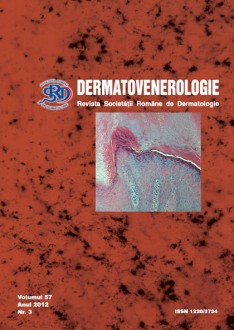Clinical cases
Generalized Morphea
Scleroderma is a connective tissue disease of unknown cause and with autoimmune mechanism, characterized through a marked fibrosis of the dermis and epidermal atrophy, with or without visceral involvement. Generalized morphea is a particular form of localized scleroderma, presenting typical scleroderma plaques, extensive and located at the level of at least 4 anatomical regions.
We present the case of 73 years old patient, diagnosed with generalized morphea, pathology confirmed, with positive serology for Borellia burgdorferi, for which he received Doxycycline treatment for 3 months, with further negativity serology, currently being under immunosuppressive therapy. Objective clinical examination revealed lesions in different stages of development: erythematous- edematous plaques, located at the level of the thighs, plaques with central wood-like induration and waxyellowed colour, with periphery marked by a red-violaceae halo ("lilac ring"), most of them confluence with location on the torso, arms and legs.
Since the first admissions were objectified elevated antinuclear antibodies and of immunogram, given the aggressiveness and extension of skin lesions, the suspicion of systemic scleroderma was raised, but the absence of Raynaud's phenomenon, of systemic damage, of acrosclerose pleaded for generalized morphea, initiating a stepwise treatment with systemic corticosteroids, synthesis antipaludiques and immunosuppressive, with favorable evolution.
The case presented brings into question the involvement of Borellia burgdorferi in triggering scleroderma and therapeutic difficulties in the case of generalized morphea form.


